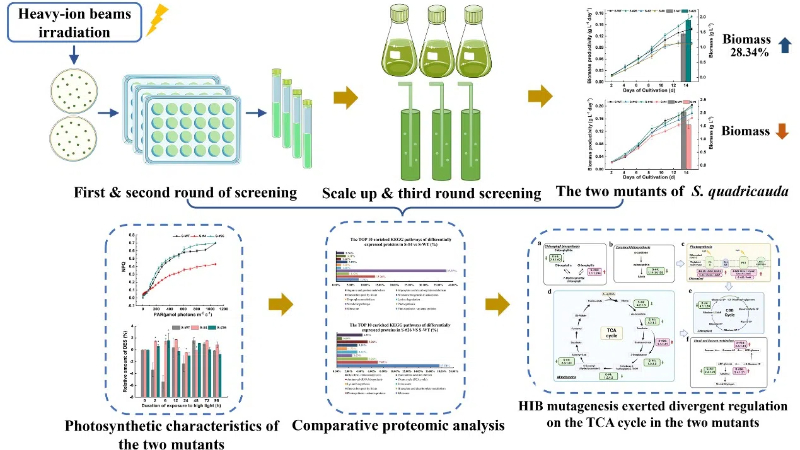Home / News / Latest News
18 07, 2024
Researchers Provide New Approach for Developing Engineering Microalgae Strains
In a recent study published in Bioresource Technology, researchers have revealed that heavy-ion beams mutagenesis could affect energy and carbon metabolism in microalgae mutants, providing a new approach for developing engineering microalgae strains with enhanced carbon fixation abilities.
The study was carried out by researchers from the Institute of Modern Physics (IMP) of the Chinese Academy of Sciences and their collaborators.
Microalgae possess a strong ability to convert solar energy and carbon dioxide into biomass and high-value bioproducts. With broad applications in carbon capture, utilization, and storage, as well as waste treatment, microalgae can play a significant role in achieving China’s dual-carbon goals.
However, the biotechnological applications of microalgae have been limited due to the lack of comprehensive understanding of their carbon metabolism and energy conversion. Aimed at coordinating energy utilization and carbon allocation, strain improvement is emerging as a promising strategy.
Using the Heavy Ion Research Facility in Lanzhou (HIRFL), the researchers applied the effective strain improvement technique, heavy-ion beams mutagenesis, to the environmentally adaptable microalgae Scenedesmus quadricauda.
After several rounds of screening, the researchers identified two distinct mutants. One mutant showed low photosynthetic activity and biomass productivity, while the other mutant demonstrated adaptability to prolonged high light stress and achieved a 28.34 % increase in biomass yield compared with the wild-type strain.
Integrating their photosynthetic characteristics with comparative proteomics analysis, researchers discovered that the contrasting protein regulations from central carbon metabolism mainly affect the different biomass accumulation patterns of the two mutants.
Furthermore, the researchers found that divergent regulation of the tricarboxylic acid cycle following heavy-ion beams mutagenesis could be potential targets for developing engineering microalgal strains with superior biomass and high-value products.
This study shows that heavy-ion beams mutagenesis is a powerful breeding technique, which has significant advantages in producing robust microalgal mutant strains with potential for industrial applications.
This work was supported by the National Natural Science Foundation of China, the Natural Science Foundation of Gansu Province, and the National Key Research and Development Program of China.

Figure. Schematic representation of study workflow (Image by WANG Jie)
Appendix(s):
Contact Information
Institute of Modern Physics
Email: fangliu@impcas.ac.cn



 甘公网安备 62010202000713号
甘公网安备 62010202000713号


